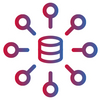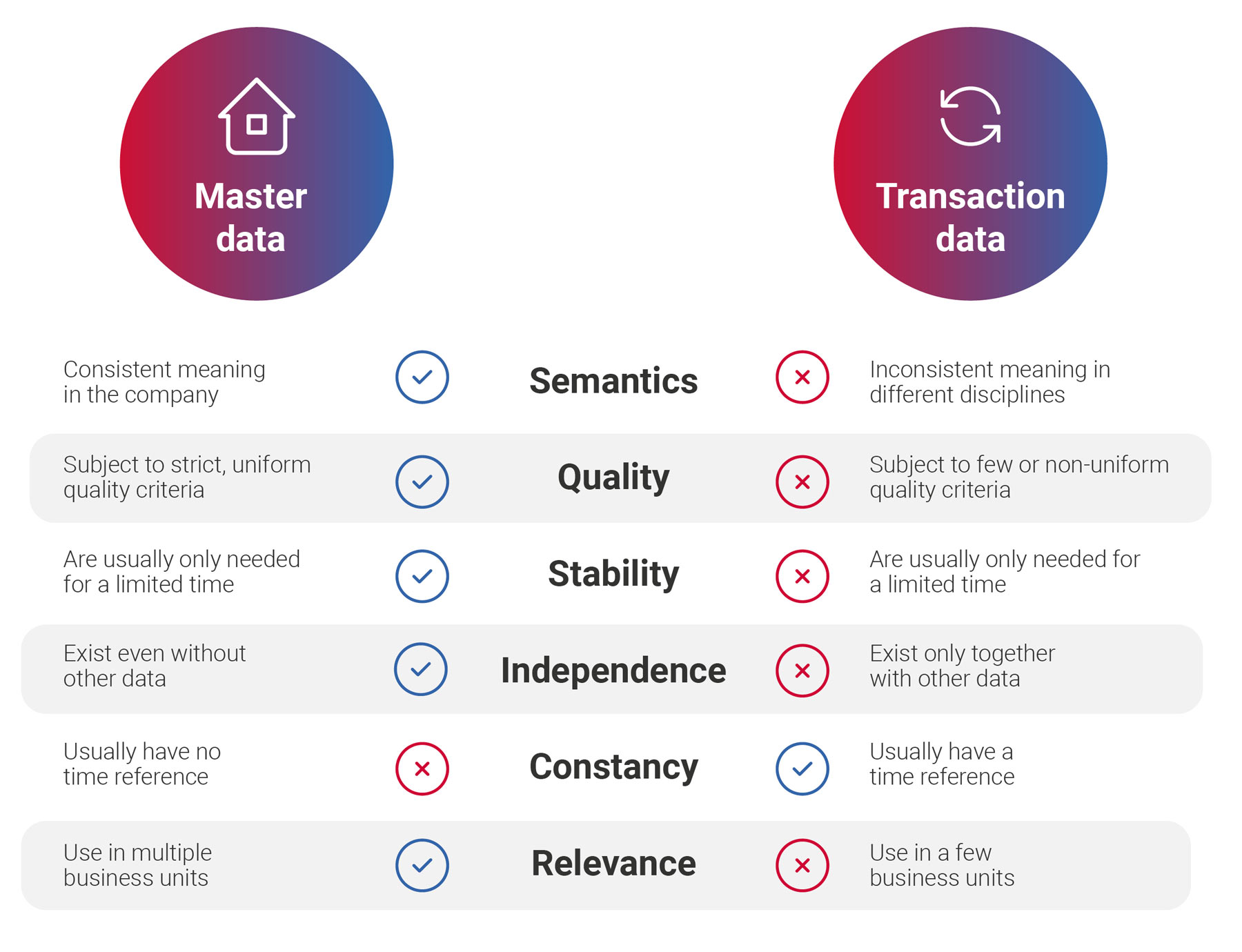Master Data Management
Master data in the company
Valuable as gold, often criminally neglected
Every company has master data. In order for business processes in which this master data is required to operate reliably, the data must be of an appropriate quality. In particular, it must be up-to-date, complete, correct and unambiguous, as well as centrally available. With our expertise and our tools, we at Uniserv, as customer data experts, will also solve your challenges in master data management in the domain of customers and interested parties together with you.

Master Data.
The data foundation of every company.
Just as an internal combustion engine needs fuel and lubricants, a company needs data to function. Basically, a distinction is made between master data and transaction data. While master data, such as a customer's address, e-mail address and bank details, is fixed, i.e. rather static, transaction data is dynamic data. It arises from ongoing operations, such as information from interaction with customers and suppliers, for example, during the processing of deliveries and orders or via dialogs by phone, e-mail or in social media.
As static, firmly defined data, master data forms the foundation of a company. The more solid the foundation, the more stable the superstructure. Applied to master data, this means: if the quality of the master data is adequate, the business processes, ergo the entire company, will smoothly perform. Conversely, if the master data is of poor quality, the processes suffer and so does the entire company. Consequently, it is critical for the economic resilience of a company to devote a permanently high level of attention to its master data, in the sense of constant quality assurance. This brings us to master data management.
Of particular importance is the management of customer master data, i.e., all data linked to customers, especially the postal address, e-mail address, bank data, and telephone numbers. Ultimately, the economic success of a company depends to a large extent on the quality of this customer master data. How can a company operate successfully in the market if the customer data is incorrect or at least of poor quality?
Consequences of poor master data quality
If the master data of a company does not have the required quality, i.e. if it is, for example, neither up-to-date, nor complete, nor correct, nor unambiguous, this will result in particular in the consequences mentioned below. Especially when you consider that the master data in companies is usually stored in different systems.
- No first time right principle with data quality firewall to automatically ensure correct data.
- No real "unique customer ID" across systems or data sets, resulting in redundancies and inconsistencies within and across systems.
- No consolidation of different data sets of the same customer possible. No true 360-degree customer view.
- No standard processes to avoid aging of data (anti-aging).
- Problems with operational, customer-facing business processes that rely on this data.

But that is by far not all. Unfortunately. Such poor data is also difficult or impossible to analyze. Accordingly, decisions are made on such an uncertain basis. The decisions are difficult to trust.
This overview of negative consequences could be continued almost indefinitely. But despite all the difficulties, there are also two pieces of good news. On the one hand, many companies find that the quality of their master data leaves a lot to be desired. And secondly, these difficulties can be easily overcome. With the necessary expertise and the appropriate tools, master data from different sources can be integrated and consolidated in a quality-assured manner.
Advantages of consolidated and high-quality data
Consolidated and high-quality data literally form the 'foundation' for many other business processes. Many operational and analytical departments can access this data and thus contribute "their" piece of the puzzle to the 360-degree customer view. Marketing, for example, can play out targeted personalized campaigns. Or Finance can provide data-based invoices to the correct address or perform portfolio analyses without debtor duplicates. Or Business Intelligence can analyze the central database in a variety of ways and derive recommendations for action and decisions from the analysis results. To name just three examples. And to remain in the image of the combustion engine: If the wrong lubricants and fuels were used, the engine would stutter and not develop its full power. In the worst case, an engine would even break down.
Options for action
Do you have a distributed system landscape with redundant master data and want to take advantage of high-quality, consolidated master data? If so, there are several possible solutions for how you can achieve this, especially across multiple systems. But not all of them are really target-oriented and efficient.

Option 1: Doing nothing.
The most expensive solution.

Option 2: Consolidate system landscape.
Too expensive. Too risky. Too lengthy.

Option 3: Point-2-Point interfaces.
From data chaos to interface chaos.

Option 4: Workflows for data maintenance.
Very high coordination effort.

Option 5: Master Data Hub.
Best Practice!
How are master data management projects properly managed?
The purchase of a master data management system alone does not solve the problem. The success of MDM initiatives depends on the triad of creating awareness, knowing the project stages, and using the right solution. Master data management projects fail if all three aspects are not adequately addressed.
1. Awareness
First and foremost, master data management that serves the company's goals requires that the master data management philosophy and awareness of the need for high-quality master data are firmly anchored in the corporate culture, and that this awareness is also constantly maintained and renewed. Master data and its maintenance must not be perceived by employees as a tiresome chore, but as a valuable contribution to the company's success. To this end, the importance and benefits of corporate data must be clearly explained. If necessary, a corresponding change management process must be initiated.
2. Project stages
Master data management consists of various project steps that address the following points, depending on the task at hand. Depending on the concrete objectives in the company, the project steps have different focuses.
- Definition of the objective.
- Audit of the current state.
- Initial data cleansing.
- First time right. Introduction of a data quality firewall.
- Data maintenance and anti-aging of data.
A typical task that is often thought of first is the introduction of a company-wide customer data management system. Since the introduction of such a system is usually complex and costly, people often shy away from it. This does not have to be the case. The introduction of a customer data management system can often be implemented in stages. But when there is a "fire", it is still pragmatic. Even the greatest journey begins with the first step. Typical tasks in which we support our customers with our expertise and our tools are, for example:
- ad hoc measures to integrate mass data or new uses of master data.
- improving the data quality of a single system that captures or maintains master data.
- migration projects where poor data quality should not be carried over to the new system.
- introduction of a central master data management system or its optimization.

The Uniserv Customer Success Team has expertise in the master data management project steps as well as the typical tasks and will be happy to support you in your project.
3. Solutions
A master data management system or tool alone will not lead to success without corresponding awareness in the company and without expertise in the project steps. However, with a corresponding data pool size and complexity, there is also no way to project success without suitable tools. We therefore have various solution approaches in our portfolio to meet challenges individually. Together with you, we will develop the concept that is right for you.
FAQ about master data management
Master data management, or MDM for short, and data warehousing are two terms that are often confused. It is important to differentiate between them. They stand for different concepts in the overarching context of data management. These aspects illustrate how they are related.
- Purpose: master data management focuses on managing and ensuring the quality and consistency of master data, such as customer, product and supplier data. Data warehousing, on the other hand, aims to store large amounts of data from various sources and make it available for analysis purposes.
- Data quality: master data management ensures that master data is correct, consistent and up-to-date. It creates a central source of truth known as the ‘golden record’. Data warehousing uses this high-quality data for reports and analysis without having to manage the data quality itself.
- Data integration: master data management integrates data from different systems and applications to ensure a standardized view of master data. Data warehousing collects and stores data from various sources in order to utilize it for business intelligence and reporting.
- Usage: master data management is mainly used for operational purposes to ensure that all departments have access to the same, reliable data. Data warehousing is used for strategic purposes to analyze historical data and make informed business decisions.
To summarize: master data management ensures the quality and consistency of master data, while data warehousing stores this data and makes it available for analysis of all kinds. Both approaches complement each other and contribute to improving data management and decision-making in companies.
Master data management plays a central role in data governance. Data governance means defining internal standards or data guidelines for the collection, storage, processing and deletion of master data. Data governance determines who can access which types of data, and which types of data are subject to governance. By defining clear guidelines and processes for the management of customer master data in particular, master data management supports data governance initiatives in several ways:
- Data quality: master data management ensures that master data is correct, consistent and up-to-date. Data quality is continuously monitored and improved through regular data cleansing and validation processes.
- Data standards: master data management helps to define and enforce company-wide data standards. This includes the definition of naming conventions, data formats and classifications to ensure a standardized data structure.
- Access rights: master data management supports the administration of access rights and authorizations to ensure that only authorized persons can access certain data. This protects sensitive information and prevents unauthorized changes.
- Data accountability: master data management promotes accountability for data by defining clear roles and responsibilities for data management. Data managers are responsible for the maintenance and quality of customer master data, for example.
- Transparency: master data management creates transparency in business processes by enabling comprehensible and documented data changes. This facilitates audits and the tracking of data origins and changes.
Master data management projects often get out of hand. They drag on for a long time and, in the worst case, block a company for an extended period of time. The following strategies can help:
-
Detailed project planning: this includes all phases, milestones and tasks of the master data management project in advance. If the planning is well structured, progress can be easily monitored. Adjustments can be made in good time.
-
Clear objectives and requirements: the objectives and requirements of the master data management project must be clearly defined so that everyone involved understands the expectation and works towards it.
-
Effective risk management: if potential risks are identified at an early stage, appropriate risk minimization strategies can be developed. Eliminate show stoppers. A master data management project runs more smoothly.
-
Regular monitoring and reporting: regular reviews and reports during the master data management project help to track and ensure progress and keep the project on track.
-
Stakeholder engagement: all relevant stakeholders must be involved in the master data management project and kept informed. This promotes collaboration and ensures that everyone involved is on the same page.
-
Flexibility and adaptability: you need to be and remain flexible throughout the master data management project. ‘Ongoing process’ is the credo. This allows you to react to unexpected challenges without jeopardizing the overall schedule (no late surprises).
-
Think big, start small: or to put it another way, Rome wasn't built in a day either. In master data management, it can be helpful to first connect and analyze just one or two data sources. If you want everything at once, you can easily stumble.
-
Tools and technology: with the Master Data Hub from Uniserv, a master data management project can be significantly accelerated. The Master Data Hub contains all the data quality tools needed to prepare the customer master data directly in an appropriate quality.
Companies in almost every industry have to deal with master data, especially customer master data, in varying quantities and qualities. What they all have in common is, that, without master data management, value creation is severely impaired:
- Retail and e-commerce: customer data integration
By consolidating customer data from different channels (online shop, stationary store, customer service), personalized offers and a seamless customer experience can be guaranteed using master data management. An optimized checkout process supports the positive overall impression.
- Financial services: customer data management
Centralized administration of customer data as part of master data management enables better customer analysis and segmentation. This is important for customized financial products and services, especially when it comes to lifelong offers.
- Healthcare: patient data management
Master data management ensures that patient data is consistent and up-to-date, which is crucial for the provision of high-quality healthcare services and the coordination of patient care. High data quality is becoming increasingly important as the digitization of healthcare progresses. This is because digital healthcare applications and the electronic patient record (ePA), which has been rolled out since 15 January 2025, depend on master data of an appropriate quality.
- Energy industry: data integration and consolidation
Energy supply companies have numerous data sources, such as consumption data, connection points, generation data and grid operation data. Master data management helps to integrate and consolidate these different data sources in order to create a standardized and consistent database. Everything must be customized to the end consumer. This is crucial for a holistic view, e.g. in the area of smart metering. If energy suppliers such as regional utilities also take over municipal tasks such as public pools, fibre optic expansion or photovoltaics, additional data sources are added.
- CEP sector (courier, express and parcel services): efficient route planning and optimization
Master data management helps to manage accurate and up-to-date address data. This is essential for planning and optimizing delivery routes and delivery times. The benefits of reliable data are faster delivery times and reduced fuel consumption. From a sustainability perspective, this should not be neglected, especially on the so-called ‘last mile’. Precise and transparent tracking of consignments is also only possible with valid customer master data.
- Insurance: customer-centricity
Insurance companies are increasingly moving from a contract-centred to a customer-centred business model. Master data management helps to change the perspective by means of a cross-divisional view. With valid customer master data, a complete and standardized view of each individual customer is possible. This enables personalized services and better customer loyalty. Structured and unstructured data can also be better integrated and utilized.
You can find all the information on exciting industry cases here.
You might also be interested in:





